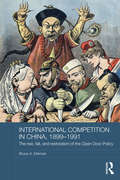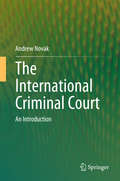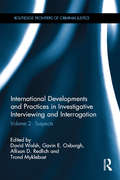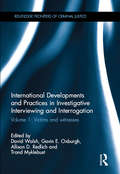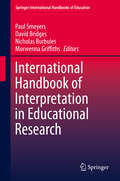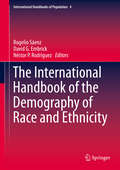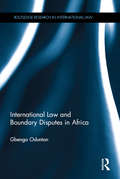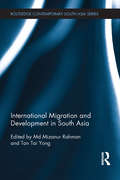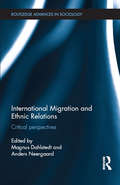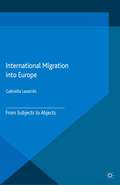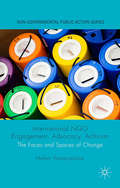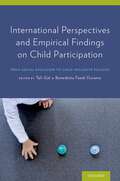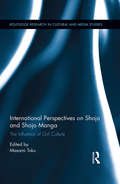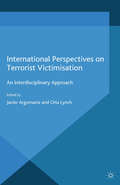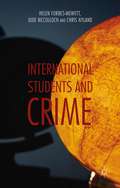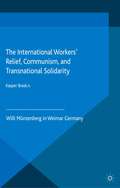- Table View
- List View
International Competition in China, 1899-1991: The Rise, Fall, and Restoration of the Open Door Policy (Routledge Studies in the Modern History of Asia)
by Bruce A. EllemanChina's recent economic reforms have opened its economy to the world. This policy, however, is not new: in the late nineteenth century, the United States put forward the Open Door Policy as a counter to European exclusive 'spheres of influence' in China. This book, based on extensive original archival research, examines and re-evaluates China's Open Door Policy. It considers the policy from its inception in 1899 right through to the post-1978 reforms. It relates these changes to the various shifts in China’s international relations, discusses how decades of foreign invasion, civil war and revolution followed the destruction of the policy in the 1920s, and considers how the policy, when applied in Taiwan after 1949, and by Deng Xiaoping in mainland China after 1978, was instrumental in bringing about, respectively, Taiwan's 'economic miracle' and mainland China’s recent economic boom. The book argues that, although the policy was characterised as United States 'economic imperialism' during the Cold War, in reality it helped China retain its sovereignty and territorial integrity.
International Competition in China, 1899-1991: The Rise, Fall, and Restoration of the Open Door Policy (Routledge Studies in the Modern History of Asia)
by Bruce A. EllemanChina's recent economic reforms have opened its economy to the world. This policy, however, is not new: in the late nineteenth century, the United States put forward the Open Door Policy as a counter to European exclusive 'spheres of influence' in China. This book, based on extensive original archival research, examines and re-evaluates China's Open Door Policy. It considers the policy from its inception in 1899 right through to the post-1978 reforms. It relates these changes to the various shifts in China’s international relations, discusses how decades of foreign invasion, civil war and revolution followed the destruction of the policy in the 1920s, and considers how the policy, when applied in Taiwan after 1949, and by Deng Xiaoping in mainland China after 1978, was instrumental in bringing about, respectively, Taiwan's 'economic miracle' and mainland China’s recent economic boom. The book argues that, although the policy was characterised as United States 'economic imperialism' during the Cold War, in reality it helped China retain its sovereignty and territorial integrity.
The International Criminal Court: An Introduction (SpringerBriefs in Law)
by Andrew NovakThis book is about the International Criminal Court (ICC), a new and highly distinctive criminal justice institution with the ability to prosecute the highest-level government officials, including heads of state, even in countries that have not accepted its jurisdiction. The book explores the historical development of international criminal law and the formal legal structure created by the Rome Statute, against the background of the Court’s search for objectivity in a political global environment. The book reviews the operations of the Court in practice and the Court’s position in the power politics of the international system. It discusses and clarifies all stages of an international criminal proceeding from the opening of the investigation to sentencing, reparations, and final appeals in the context of its restorative justice mission. Making appropriate comparisons and contrasts between the international criminal justice system and domestic and national systems, the book fills a gap in international criminal justice study.
International Developments and Practices in Investigative Interviewing and Interrogation: Volume 2: Suspects (Routledge Frontiers of Criminal Justice)
by David Walsh Gavin E. Oxburgh Alison D. Redlich Trond MyklebustTechniques in the investigative interviewing and interrogation of victims, witnesses and suspects of crime vary around the world, according to a country’s individual legal system, religion and culture. Whereas some countries have developed certain interview protocols for witnesses (such as the ABE Guidelines and the NICHD protocol when interviewing children) and the PEACE model of interviewing suspects, other countries continue to use physical coercion and other questionable tactics to elicit information. Until now, there has been very little empirical information about the overall interview and interrogation practices in non-western countries, especially the Middle and Far East. This book addresses this gap, bringing together international experts from over 25 countries and providing in-depth coverage of the various interview and interrogation techniques used across the globe. Volume 2 focuses on the interviewing of crime suspects, aiming to provide the necessary information for an understanding of how law enforcement agencies around the world gain valuable information from suspects in criminal cases. Together, the chapters that make up this volume and the accompanying volume on interviewing witnesses and victims, draw on specific national case studies and practices, examine contemporary challenges and identify best practice to enable readers to develop an international, as well as a comparative, perspective of developments worldwide in this important area of criminal investigation. This book will be an essential resource for academics and students engaged in the study of policing, criminal investigation, forensic psychology and criminal law. It will also be of great interest to practitioners, legal professionals and policymakers around the world.
International Developments and Practices in Investigative Interviewing and Interrogation: Volume 2: Suspects (Routledge Frontiers of Criminal Justice)
by David Walsh Gavin E. Oxburgh Allison D. Redlich Trond MyklebustTechniques in the investigative interviewing and interrogation of victims, witnesses and suspects of crime vary around the world, according to a country’s individual legal system, religion and culture. Whereas some countries have developed certain interview protocols for witnesses (such as the ABE Guidelines and the NICHD protocol when interviewing children) and the PEACE model of interviewing suspects, other countries continue to use physical coercion and other questionable tactics to elicit information. Until now, there has been very little empirical information about the overall interview and interrogation practices in non-western countries, especially the Middle and Far East. This book addresses this gap, bringing together international experts from over 25 countries and providing in-depth coverage of the various interview and interrogation techniques used across the globe. Volume 2 focuses on the interviewing of crime suspects, aiming to provide the necessary information for an understanding of how law enforcement agencies around the world gain valuable information from suspects in criminal cases. Together, the chapters that make up this volume and the accompanying volume on interviewing witnesses and victims, draw on specific national case studies and practices, examine contemporary challenges and identify best practice to enable readers to develop an international, as well as a comparative, perspective of developments worldwide in this important area of criminal investigation. This book will be an essential resource for academics and students engaged in the study of policing, criminal investigation, forensic psychology and criminal law. It will also be of great interest to practitioners, legal professionals and policymakers around the world.
International Developments and Practices in Investigative Interviewing and Interrogation: Volume 1: Victims and witnesses (Routledge Frontiers of Criminal Justice)
by David Walsh Gavin E. Oxburgh Alison D. Redlich Trond MyklebustTechniques in the investigative interviewing and interrogation of victims, witnesses and suspects of crime vary around the world, according to a country’s individual legal system, religion and culture. Whereas some countries have developed certain interview protocols for witnesses (such as the ABE Guidelines and the NICHD protocol when interviewing children) and the PEACE model of interviewing suspects, other countries continue to use physical coercion and other questionable tactics to elicit information. Until now, there has been very little empirical information about the overall interview and interrogation practices in non-western countries, especially the Middle and Far East. This book addresses this gap, bringing together international experts from over 25 countries and providing in-depth coverage of the various interview and interrogation techniques used across the globe. Volume 1 focuses on the interviewing of victims and witnesses, aiming to provide the necessary information for an understanding of how law enforcement agencies around the world gain valuable information from victims and witnesses in criminal cases. Together, the chapters that make up this volume and the accompanying volume on interviewing suspects, draw on specific national case studies and practices, examine contemporary challenges and identify best practice to enable readers to develop an international, as well as a comparative, perspective of developments worldwide in this important area of criminal investigation. This book will be an essential resource for academics and students engaged in the study of policing, criminal investigation, forensic psychology and criminal law. It will also be of great interest to practitioners, legal professionals and policymakers around the world.
International Developments and Practices in Investigative Interviewing and Interrogation: Volume 1: Victims and witnesses (Routledge Frontiers of Criminal Justice)
by David Walsh Gavin E. Oxburgh Allison D. Redlich Trond MyklebustTechniques in the investigative interviewing and interrogation of victims, witnesses and suspects of crime vary around the world, according to a country’s individual legal system, religion and culture. Whereas some countries have developed certain interview protocols for witnesses (such as the ABE Guidelines and the NICHD protocol when interviewing children) and the PEACE model of interviewing suspects, other countries continue to use physical coercion and other questionable tactics to elicit information. Until now, there has been very little empirical information about the overall interview and interrogation practices in non-western countries, especially the Middle and Far East. This book addresses this gap, bringing together international experts from over 25 countries and providing in-depth coverage of the various interview and interrogation techniques used across the globe. Volume 1 focuses on the interviewing of victims and witnesses, aiming to provide the necessary information for an understanding of how law enforcement agencies around the world gain valuable information from victims and witnesses in criminal cases. Together, the chapters that make up this volume and the accompanying volume on interviewing suspects, draw on specific national case studies and practices, examine contemporary challenges and identify best practice to enable readers to develop an international, as well as a comparative, perspective of developments worldwide in this important area of criminal investigation. This book will be an essential resource for academics and students engaged in the study of policing, criminal investigation, forensic psychology and criminal law. It will also be of great interest to practitioners, legal professionals and policymakers around the world.
The International Film Business: A Market Guide Beyond Hollywood
by Angus FinneyThe International Film Business examines the independent film sector as a business, and addresses the specific skills and knowledge it demands. It describes both the present state of the industry, the significant digital and social media developments that are continuing to take place, and what changes these might effect. The International Film Business: describes and analyses the present structure of the film industry as a business, with a specific focus on the film value chain discusses and analyses current digital technology and how it potentially may change the structure and opportunities offered by the industry in the future provides information and advice on the different business and management skills and strategies includes case studies on a variety of films including The Guard (2011), The King’s Speech (2010), The Best Exotic Marigold Hotel (2012), Cloverfield (2008), Pobby & Dingan (aka Opal Dream, 2005), Confessions of a Dangerous Mind (2002), The Reckoning (2002)and The Mother (2003), and company case studies on Pixar, Renaissance, Redbus and Zentropa. Further case studies on films that failed to go into production include Neil LaBute’s Vapor and Terry Gilliam’s Good Omens. Taking an entrepreneurial perspective on what future opportunities will be available to prepared and informed students and emerging practitioners, this text includes case studies that take students through the successes and failures of a variety of real film companies and projects and features exclusive interviews with leading practitioners in all sectors of the industry, from production to exhibition.
The International Film Business: A Market Guide Beyond Hollywood
by Angus FinneyThe International Film Business examines the independent film sector as a business, and addresses the specific skills and knowledge it demands. It describes both the present state of the industry, the significant digital and social media developments that are continuing to take place, and what changes these might effect. The International Film Business: describes and analyses the present structure of the film industry as a business, with a specific focus on the film value chain discusses and analyses current digital technology and how it potentially may change the structure and opportunities offered by the industry in the future provides information and advice on the different business and management skills and strategies includes case studies on a variety of films including The Guard (2011), The King’s Speech (2010), The Best Exotic Marigold Hotel (2012), Cloverfield (2008), Pobby & Dingan (aka Opal Dream, 2005), Confessions of a Dangerous Mind (2002), The Reckoning (2002)and The Mother (2003), and company case studies on Pixar, Renaissance, Redbus and Zentropa. Further case studies on films that failed to go into production include Neil LaBute’s Vapor and Terry Gilliam’s Good Omens. Taking an entrepreneurial perspective on what future opportunities will be available to prepared and informed students and emerging practitioners, this text includes case studies that take students through the successes and failures of a variety of real film companies and projects and features exclusive interviews with leading practitioners in all sectors of the industry, from production to exhibition.
International Handbook of Interpretation in Educational Research (Springer International Handbooks of Education)
by Paul Smeyers David Bridges Nicholas C. Burbules Morwenna GriffithsThis handbook focuses on the often neglected dimension of interpretation in educational research. It argues that all educational research is in some sense ‘interpretive’, and that understanding this issue belies some usual dualisms of thought and practice, such as the sharp dichotomy between ‘qualitative’ and ‘quantitative’ research. Interpretation extends from the very framing of the research task, through the sources which constitute the data, the process of their recording, representation and analysis, to the way in which the research is finally or provisionally presented. The thesis of the handbook is that interpretation cuts across the fields (both philosophically, organizationally and methodologically).By covering a comprehensive range of research approaches and methodologies, the handbook gives (early career) researchers what they need to know in order to decide what particular methods can offer for various educational research contexts/fields. An extensive overview includes concrete examples of different kinds of research (not limited for example to ‘teaching’ and ‘learning’ examples as present in the Anglo-Saxon tradition, but including as well what in the German Continental tradition is labelled ‘pädagogisch’, examples from child rearing and other contexts of non-formal education) with full description and explanation of why these were chosen in particular circumstances and reflection on the wisdom or otherwise of the choice – combined in each case with consideration of the role of interpretation in the process. The handbook includes examples of a large number of methods traditionally classified as qualitative, interpretive and quantitative used across the area of the study of education. Examples are drawn from across the globe, thus exemplifying the different ‘opportunities and constraints’ that educational research has to confront in different societies.
The International Handbook of the Demography of Race and Ethnicity (International Handbooks of Population #4)
by Rogelio Sáenz David G. Embrick Néstor P. RodríguezExamining key countries in every region of world, this handbook presents population profiles and analyses concerning racial/ethnic disparities and changing intergroup relations. Inside, prominent scholars from various parts of the world and disciplines address the links between stratification, demography, and conflict across the globe.Organized by region/continent, coverage for each profiled country includes demographic information; a historical overview that addresses past racial/ethnic conflict; identification of the most salient demographic trends and issues that the country faces; theoretical issues related to the linkages between stratification, demography, and conflict; methodological issues including quality of data and cutting-edge methods to better understand the issue at hand; and details on the possible future of the existing trends and issues with particular emphasis on public policy and human rights.This handbook will help readers to better understand the commonalities and differences that exist globally in the interplay between stratification, demography, and conflict. In addition, it also provides an excellent inventory of theoretical perspectives and methodological approaches that are needed to better comprehend this issue.This handbook will appeal to students, researchers, and policy analysts in the areas of race and ethnic relations, demography, inequality, international sociology, international relations, foreign studies, social geography, and social development.
International Law and Boundary Disputes in Africa (Routledge Research in International Law)
by Gbenga OduntanAfrica has experienced a number of territorial disputes over land and maritime boundaries, due in part to its colonial and post-colonial history. This book explores the legal, political, and historical nature of disputes over territory in the African continent, and critiques the content and application of contemporary International law to the resolution of African territorial and border disputes. Drawing on central concepts of public international law such as sovereignty and jurisdiction, and socio-political concepts such as colonialism, ethnicity, nationality and self-determination, this book interrogates the intimate connection that peoples and nations have to territory and the severe disputes these may lead to. Gbenga Oduntan identifies the major principles of law at play in relation to territorial, and boundary disputes, and argues that the predominant use of foreign based adjudicatory mechanisms in attempting to deal with African boundary disputes alienates those institutions and mechanisms from African people and can contribute to the recurrence of conflicts and disputes in and among African territories. He suggests that the understanding and application of multidisciplinary dispute resolution mechanisms and strategies can allow for a more holistic and effective treatment of boundary disputes. As an in depth study into the legal, socio-political and anthropological mechanisms involved in the understanding of territorial boundaries, and a unique synthesis of an African jurisprudence of international boundaries law, this book will be of great use and interest to students, researchers, and practitioners in African and Public International Law, International Relations, and decision-makers in need of better understanding the settlement of disputes over territorial boundaries in both Africa and the wider world.
International Law and Boundary Disputes in Africa (Routledge Research in International Law)
by Gbenga OduntanAfrica has experienced a number of territorial disputes over land and maritime boundaries, due in part to its colonial and post-colonial history. This book explores the legal, political, and historical nature of disputes over territory in the African continent, and critiques the content and application of contemporary International law to the resolution of African territorial and border disputes. Drawing on central concepts of public international law such as sovereignty and jurisdiction, and socio-political concepts such as colonialism, ethnicity, nationality and self-determination, this book interrogates the intimate connection that peoples and nations have to territory and the severe disputes these may lead to. Gbenga Oduntan identifies the major principles of law at play in relation to territorial, and boundary disputes, and argues that the predominant use of foreign based adjudicatory mechanisms in attempting to deal with African boundary disputes alienates those institutions and mechanisms from African people and can contribute to the recurrence of conflicts and disputes in and among African territories. He suggests that the understanding and application of multidisciplinary dispute resolution mechanisms and strategies can allow for a more holistic and effective treatment of boundary disputes. As an in depth study into the legal, socio-political and anthropological mechanisms involved in the understanding of territorial boundaries, and a unique synthesis of an African jurisprudence of international boundaries law, this book will be of great use and interest to students, researchers, and practitioners in African and Public International Law, International Relations, and decision-makers in need of better understanding the settlement of disputes over territorial boundaries in both Africa and the wider world.
International Migration and Development in South Asia (Routledge Contemporary South Asia Series)
by Mizanur Rahman Tai Yong TanIn migration studies, the nexus between migration and development in the global South has been meticulously debated. However, a unanimous resolution to this debate has not been found, due to the ever-changing nature of international migration. This book advances knowledge on the global debate on the migration-development relationship by documenting experiences in a number of countries in South Asia. Drawing on the experiences of global South Asians, this volume documents the impact of migration on the social, economic, and political fields in the broader context of development. It also presents a regional experience by looking into the migration-development nexus in the context of South Asia, and analyses the role South Asian migrants and diaspora communities play in the South Asian society. Contributions from a variety of disciplinary backgrounds, including sociology, anthropology, political science, international relations and economics, document the development implications of South Asian migration. Broad in scope in terms of contents, timeline of migration, and geographical coverage, the book presents empirically-based case studies involving India, Bangladesh, Sri Lanka, Pakistan, and Nepal and their emigrants living and working in different parts of the world. Going beyond reporting the impacts of migration on economic development by highlighting the implications of ‘social development’ on society, this book provides a fascinating contribution to the fields of Asian Development, Migration Studies and South Asian Studies.
International Migration and Development in South Asia (Routledge Contemporary South Asia Series)
by Md Mizanur Rahman Tan Tai YongIn migration studies, the nexus between migration and development in the global South has been meticulously debated. However, a unanimous resolution to this debate has not been found, due to the ever-changing nature of international migration. This book advances knowledge on the global debate on the migration-development relationship by documenting experiences in a number of countries in South Asia. Drawing on the experiences of global South Asians, this volume documents the impact of migration on the social, economic, and political fields in the broader context of development. It also presents a regional experience by looking into the migration-development nexus in the context of South Asia, and analyses the role South Asian migrants and diaspora communities play in the South Asian society. Contributions from a variety of disciplinary backgrounds, including sociology, anthropology, political science, international relations and economics, document the development implications of South Asian migration. Broad in scope in terms of contents, timeline of migration, and geographical coverage, the book presents empirically-based case studies involving India, Bangladesh, Sri Lanka, Pakistan, and Nepal and their emigrants living and working in different parts of the world. Going beyond reporting the impacts of migration on economic development by highlighting the implications of ‘social development’ on society, this book provides a fascinating contribution to the fields of Asian Development, Migration Studies and South Asian Studies.
International Migration and Ethnic Relations: Critical Perspectives (Routledge Advances in Sociology)
by Magnus Dahlstedt Anders NeergaardEach day, in so many aspects of daily life, we are reminded of the significance of migration and ethnicity. This book is a critical contribution to the understanding of the phenomena of migration and ethnicity, from a Swedish vantage point looking outwards towards a European context. It presents current academic debates and gives a theoretical overview of nine key concepts in the field of ethnic and migrations studies, but it also exemplifies how these concepts could be used in analysing specific empirical cases. It explores the following concepts: ethnicity; migration; diaspora; citizenship; intersectionality; racism; right wing populism; social exclusion; and informalisation. The book is interdisciplinary, embracing areas such as labour studies, economic history, ethnicity, business administration, gender studies, literature studies, economics, educational science, social anthropology, social work, sociology and political science.
International Migration and Ethnic Relations: Critical Perspectives (Routledge Advances in Sociology)
Each day, in so many aspects of daily life, we are reminded of the significance of migration and ethnicity. This book is a critical contribution to the understanding of the phenomena of migration and ethnicity, from a Swedish vantage point looking outwards towards a European context. It presents current academic debates and gives a theoretical overview of nine key concepts in the field of ethnic and migrations studies, but it also exemplifies how these concepts could be used in analysing specific empirical cases. It explores the following concepts: ethnicity; migration; diaspora; citizenship; intersectionality; racism; right wing populism; social exclusion; and informalisation. The book is interdisciplinary, embracing areas such as labour studies, economic history, ethnicity, business administration, gender studies, literature studies, economics, educational science, social anthropology, social work, sociology and political science.
International Migration into Europe: From Subjects to Abjects (Migration, Diasporas and Citizenship)
by Gabriella LazaridisThis book aims to decipher the complex web of structural, institutional and cultural contradictions which shape the inclusion-exclusion dialectic and the multifaceted grid within which the 'us' becomes the 'other' and the 'other' becomes the 'us'. It looks at how international migrants in Europe transform from legal subjects into legal abjects.
International NGO Engagement, Advocacy, Activism: The Faces and Spaces of Change (Non-Governmental Public Action)
by Helen YanacopulosThe world of international non-governmental organisations (INGOs) has dramatically changed during the last two decades. The author critically analyses the engagement of INGOs within the contemporary international development landscape, enabling readers to further understand INGOs involvement in the politics of social change.
International Perspectives and Empirical Findings on Child Participation: From Social Exclusion to Child-Inclusive Policies
by Tali Gal Benedetta DuramyThe 1989 UN Convention on the Rights of the Child has inspired advocates and policy makers across the globe, injecting children's rights terminology into various public and private arenas. Children's right to participate in decision-making processes affecting their lives is the acme of the Convention and its central contribution to the children's rights discourse. At the same time the participation right presents enormous challenges in its implementation. Laws, regulations and mechanisms addressing children's right to participate in decision-making processes affecting their lives have been established in many jurisdictions across the globe. Yet these worldwide developments have only rarely been accompanied with empirical investigations. The effectiveness of various policies in achieving meaningful participation for children of different ages, cultures and circumstances have remained largely unproven empirically. Therefore, with the growing awareness of the importance of evidence-based policies, it becomes clear that without empirical investigations on the implementation of children's right to participation it is difficult to promote their effective inclusion in decision making. This book provides a much-needed, first broad portrayal of how child participation is implemented in practice today. Bringing together 19 chapters written by prominent authors from the United States, Canada, the United Kingdom, Ireland, New Zealand, Australia, and Israel, the book includes descriptions of programs that engage children and youth in decision-making processes, as well as insightful findings regarding what children, their families, and professionals think about these programs. Beyond their contribution to the empirical evidence on ways children engage in decision-making processes, the volume's chapters contribute to the theoretical development of the meaning of "participation," "citizenship," "inclusiveness," and "relational rights" in regards to children and youth. There is no matching to the book's scope both in terms of its breadth of subjects and the diversity of jurisdictions it covers. The book's chapters include experiences of child participation in special education, child protection, juvenile justice, restorative justice, family disputes, research, and policy making.
International Perspectives on Shojo and Shojo Manga: The Influence of Girl Culture (Routledge Research in Cultural and Media Studies)
by Masami TokuThis collaborative book explores the artistic and aesthetic development of shojo, or girl, manga and discusses the significance of both shojo manga and the concept of shojo, or girl culture. It features contributions from manga critics, educators, and researchers from both manga’s home country of Japan and abroad, looking at shojo and shojo manga’s influence both locally and globally. Finally, it presents original interviews of shojo manga-ka, or artists, who discuss their work and their views on this distinct type of popular visual culture.
International Perspectives on Shojo and Shojo Manga: The Influence of Girl Culture (Routledge Research in Cultural and Media Studies)
by Masami TokuThis collaborative book explores the artistic and aesthetic development of shojo, or girl, manga and discusses the significance of both shojo manga and the concept of shojo, or girl culture. It features contributions from manga critics, educators, and researchers from both manga’s home country of Japan and abroad, looking at shojo and shojo manga’s influence both locally and globally. Finally, it presents original interviews of shojo manga-ka, or artists, who discuss their work and their views on this distinct type of popular visual culture.
International Perspectives on Terrorist Victimisation: An Interdisciplinary Approach (Rethinking Political Violence)
by Javier Argomaniz Orla LynchConsidering an under-researched dimension of political violence, this interdisciplinary collection provides an extensive examination of terrorist victimisation. It explores how individual and public experiences of victimisation are constructed and how they are shaped by existing dynamics of violence.
International Students and Crime
by H. Forbes-Mewett J. McCulloch C. NylandInternational students and crime is an issue that impacts on lucrative international student markets, international relations, host countries' reputations, and the security of the broader population. This book presents vital new analyses on international students as victims and perpetrators of crime in Australia, the US and the UK.
The International Workers’ Relief, Communism, and Transnational Solidarity: Willi Münzenberg in Weimar Germany (Palgrave Studies in the History of Social Movements)
by Kasper BraskénThe first major study on the making of new cultures, movements and public celebrations of transnational solidarity in Weimar Germany. The book shows how solidarity was used to empower the oppressed in their liberation and resistance movements and how solidarity networks transferred visions and ideas of an alternative global community.
